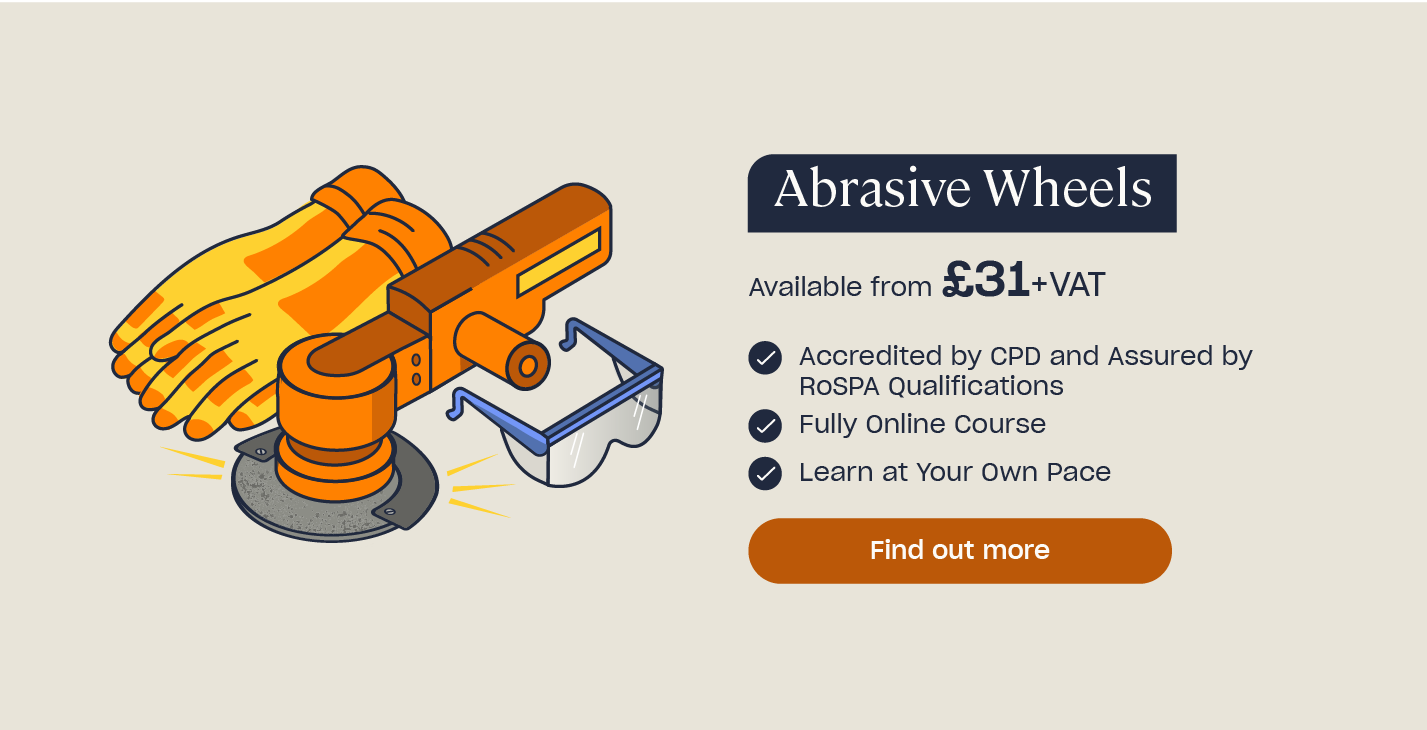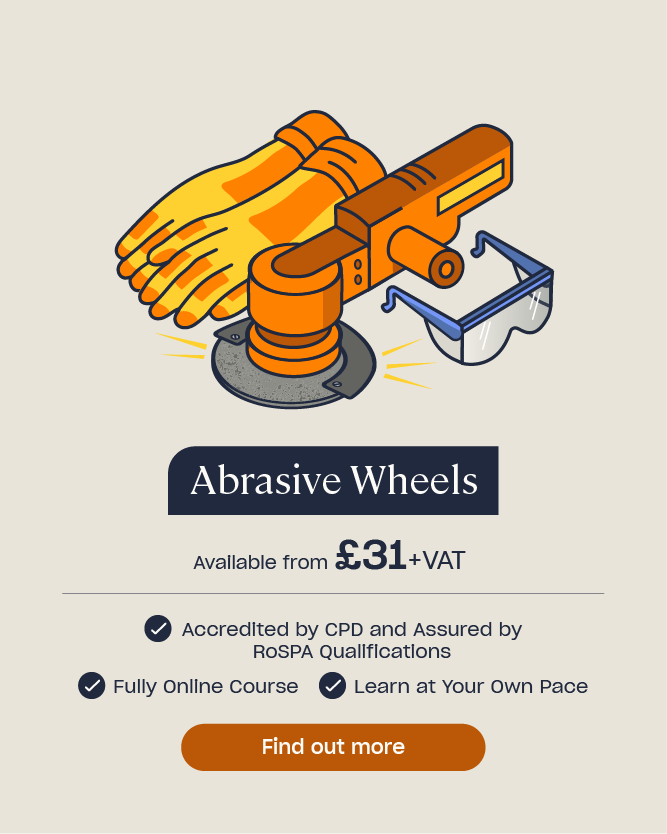What are the Hazards of Grinding?
Grinding has the potential to cause serious harm if performed incorrectly or without appropriate control measures in place. The hazards associated with grinding mainly stem from the use of abrasive wheels inside grinding machines and nearly half of accidents involving an abrasive wheel for grinding are caused by unsafe systems of work or an operator error.
If your role involves grinding and the use of abrasive wheels, or if you are responsible for teaching or supervising others who are using them, you must be aware of the hazards of grinding. This will allow you to promote cutting and grinding safety at all times. In this article, we will explain what grinding is, what makes it so dangerous and the specific hazards that come with doing it.
What is Grinding?
Grinding is an abrasive machining process that uses a machine consisting of a grinding wheel – also known as an abrasive wheel – to cut or remove material from a workpiece in order to finish it to a high quality or certain specifications.
It is a common activity in a number of industries – such as manufacturing and toolmaking – and in a variety of workplaces, such as on large construction sites or in smaller workshops. However, the type of grinding machines, or tools, you’ll find in a workplace will depend on the type of work that’s being carried out there, as different grinding machines serve different purposes, depending on their properties. You can find out more about what kind of grinding tool would be right for the work you’re doing in our article, here.
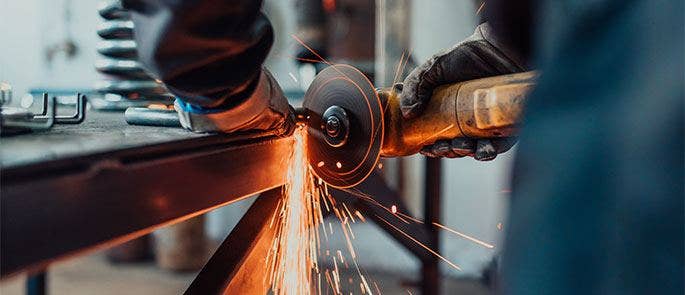
Using the right kind of grinding machine or tool for the task you’re undertaking is vitally important for safety. The two main types are hand-held portable grinders and stationary machines. The most commonly used grinding tool for industry is the angle grinder, a handheld grinder used mainly for abrasive cutting and polishing.
Other types of grinding machine include:
- Surface grinder.
- Internal grinding machine.
- Bench grinder.
- Cylindrical grinder.
- Table saw.
- Chop saw.
- Petrol saw cut-off.
The Uses of Grinding
The main purpose of grinding is to change the physical appearance and quality of a workpiece, for example by giving it a certain shape, new dimensions, a smoother surface and finish or a sharper edge. It can be performed on various materials, predominantly iron or steel, but also other hard materials like metal, stone, wood, plastic and more.
Abrasive wheels are made up of abrasive particles on their surface that are bonded together to form a hard, gritty surface. Each abrasive particle on the wheel’s surface acts as a cutting tool, making numerous tiny chips into a workpiece, creating a much larger single cut or removing large amounts of surface material from it.
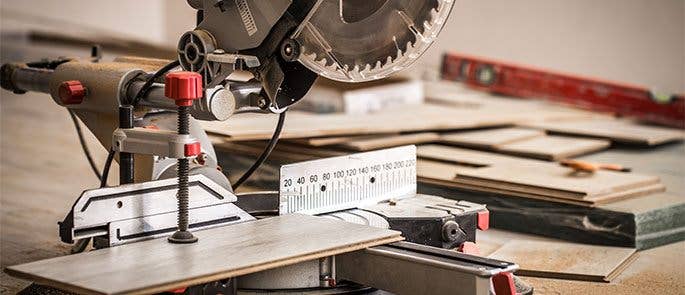
The abrasive material of the wheels is bonded together using either organic or inorganic substances. The type of bonding agent used can determine the wheel’s safety properties.
- Inorganic bonds are fired in a furnace, making the bond hard and strong, but brittle. These need to be dressed and are used for precision grinding.
- Organic bonds can handle harsher grinding conditions as they are cured at low temperatures, making the bond resilient and shock-resistant. They are self-dressing and mainly used for non-precision activities. Only organic-bonded wheels should be used for portable, hand-held grinding machines.
Looking for a Course?
If your job role involves grinding and the use of abrasive wheels, our Abrasive Wheels course teaches you about the risks of using abrasive wheels and how to work safely with them, according to legal requirements, by putting the appropriate control measures in place.
Why Can Grinding Be Dangerous?
Grinding is a dangerous activity with a large number of hazards associated with it. These hazards need to be controlled, otherwise they can pose a serious risk to the health and safety of the worker performing the task and those around them.
The main reason why grinding is so dangerous is because it uses abrasive wheels. These wheels operate at very high speeds and are designed to cut through solid materials like metal and wood, meaning they could easily damage skin and bones. Due to the stresses put on them during the work, they are also liable to break and this can also create a dangerous situation for those in the direct vicinity.
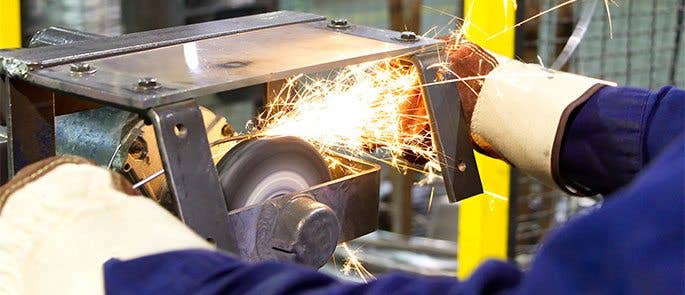
There are three main factors that will determine how dangerous a grinding job is going to be. These are:
- The competency of the machine operator.
- The nature of the wheel – including its quality, condition and suitability for the task.
- Personal Protective Equipment (PPE).
The type of grinding machine or tool you use will also impact how dangerous the grinding activity will be. For example, hand-held grinders – like angle grinders – work at a higher speed than stationary grinders and that can make them more harmful to come into contact with.
Additionally, the safety of a hand-held grinding machine is much more user-dependent as they have more control over it, creating more hazards. For example, the user could drop the machine and cause harm to themselves or someone else, or accidentally make contact with another worker while holding it.
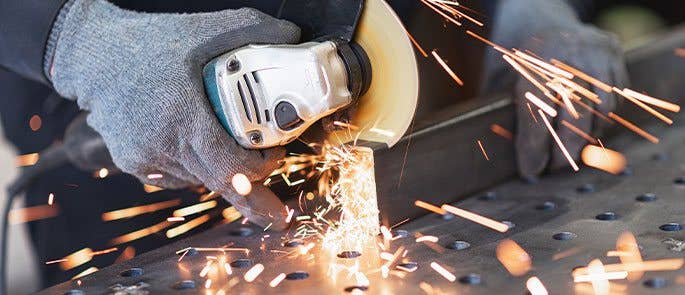
While these risks aren’t present when using a stationary grinding machine, making it generally safer to use, the two types of machine don’t perform the same functions and for some tasks a hand-held machine is necessary. It’s therefore important to be aware of these potential hazards, so that the appropriate safety precautions can be taken against them. This is essential for anyone wishing to be a competent grinding machine operator.
The main safety requirement for abrasive wheels is the Provision and Use of Work Equipment Regulations 1998 (PUWER). PUWER sets out requirements for providing and using certain equipment at work, to ensure the health and safety of workers. You can find out more about this in our article, here.
Grinding Hazards
Grinding is particularly dangerous because it can cause serious impact injuries to the body, and it can also lead to workers developing damaging, or even fatal, health conditions over time, such as pulmonary diseases and cancers. Unfortunately, workers may not realise they have developed such a condition from their work until long after they have stopped working.

We’ve listed some of the most common hazards that need to be considered when working with grinding machines with abrasive wheels below.
Contact with the Wheel
This is the most common cause of injury when using a grinding machine. Abrasive wheels turn very quickly and their abrasive surface can cause you serious superficial wounds, or in more severe cases, cuts and amputations, if you come into contact with them.
Handheld grinders pose a greater risk of contact because they are in the user’s control and their wheels turn at greater speeds than a stationary grinder.
If any part of your body comes into contact with an abrasive wheel, it can cause varying degrees of harm. There are several ways that coming into contact with the wheel can harm you if you aren’t using the machine correctly, including:
- Part of your body being trapped between the wheel and the workpiece, causing cutting and/or crushing injuries.
- Coming into contact with the wheel while it is not moving, or turning slowly, causing cuts and/or abrasions.
- Coming into contact with the wheel turning at high speeds, causing cuts, abrasions or even amputation.
Drawing In
Drawing in occurs when something comes into contact with an abrasive wheel that can be sucked into or caught in it. This could be caused by:
- Long hair – the hair could be ripped from your head or your head could be pulled into contact with the wheel.
- Something worn around the neck like a necklace, scarf or tie – this could pull your body into contact with the machine and could lead to choking injuries.
- Loose clothing or long sleeves – this could cause your body to be drawn into contact with the machine.
It’s also possible for any waste in your workplace to become drawn into the machine – for example spare rags or rubbish. When you try to remove the item that has been drawn into a machine, this can result in contact with the wheel and bodily harm.

Kickback
Kickback is the term used when a grinding wheel grabs or jams on the workpiece while it’s being cut. This can cause the user to lose control of the machine or tool which can then hit the worker or be dropped on their legs or feet.
Kickback is most commonly caused by the following:
- Using the wrong type of wheel for a particular task.
- Running a wheel at the wrong speed.
- A badly set, dull or worn wheel.
Metal Fragments
When using a grinding machine on a metal workpiece, metal fragments chip off the workpiece and can fly into the air around the worker. This is something that’s hard to avoid during grinding and poses a risk to workers’ skin and eyes if they aren’t wearing appropriate PPE.
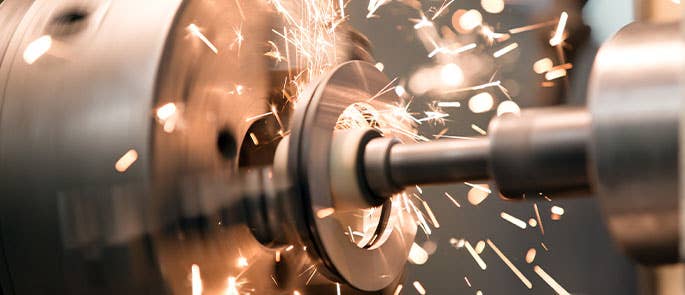
Abrasive wheels can also give off sparks as the wheel wears down and sheds abrasive particles from its surface. These can also cause harm to the skin and eyes.
In extreme cases, the whole workpiece, or parts of the workpiece, can be ejected from the machine, potentially causing serious harm if it hits the body.
Bursting Wheel
Because of the high speeds that abrasive wheels rotate at, if one were to burst while in use it could cause serious harm to the user and those around them. When a wheel bursts in use, the fragments fly off, creating high speed projectiles that can seriously harm anyone around the machine and the environment.
For this reason, there are regulations in place to limit the maximum speed that different wheels can be run that must be followed to reduce the risk of them bursting. Abrasive wheels have marking systems to provide essential information such as their maximum operating speed. To learn more about these markings, and what they tell us about each abrasive wheel, you can read our article, here.
The risk of a bursting wheel increases when wheels aren’t properly mounted and/or assembled and when the wrong wheel is used for a task.
Vibrations
Hand-held grinding machines produce vibrations that travel through the user while they’re holding it. When hand-held grinders are used for significant periods of time – considered to be more than a few hours every day – this can cause workers to develop a condition called Hand Arm Vibration Syndrome (HAVS).
HAVS can also be caused by workers holding on to a workpiece while it’s being processed in a stationary grinding machine. It is a painful and disabling health condition affecting the nerves, muscles, blood vessels and joints in a person’s hands and arms.
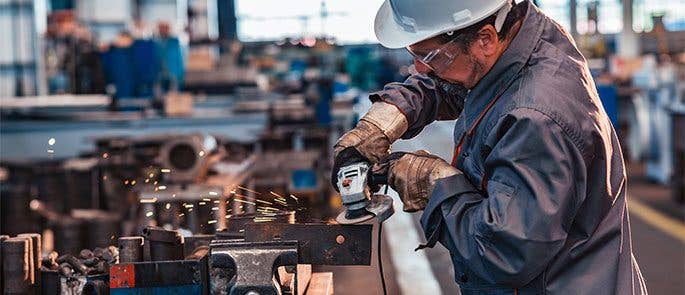
HAVS can also affect circulation and symptoms and symptoms include:
- Numb and tingling fingers which can lead to disturbed sleep.
- Loss of hand strength and grip making it difficult to pick up or hold things, particularly if they are heavy.
- Reduced sense of touch in hands and fingers causing inability to feel things.
If a worker continues to use high-vibration hand-held grinding machines, their symptoms are likely to get worse and may develop into:
- Permanently numb hands.
- An inability to pick up small or delicate objects, including work tools like nails and bolts.
- A loss of fingers due to restricted blood flow.
White finger is a long-term condition that can develop from significant use of vibrating tools and machinery. It causes the fingertips to turn white and the fingers to tingle and/or become numb.
While white finger and the other symptoms of HAVS can be prevented, there is currently no cure, so putting the appropriate safety measures in place is vital.
If you’d like to know more about HAVS guidance, check out our article, here.
Noise
Using cutting and grinding machines and tools creates a high level of noise pollution. This poses a risk to both workers on a site and the general public outside it. Noise can damage hearing if it’s loud enough and someone is exposed to it for a significant amount of time.
Noise damage can be disabling if it prevents you from being able to hear and understand speech, hear loud sounds, to engage in conversations or to communicate over the phone.
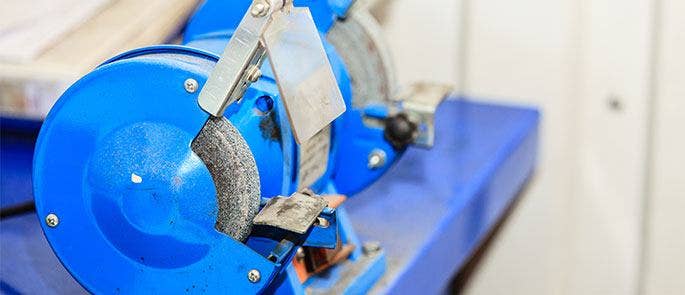
Unfortunately, hearing problems can develop slowly, making it difficult to identify that they are happening. Sometimes, you may not realise you have experienced hearing damage until you are at an age where you start to experience hearing loss naturally, and it can be much more impaired due to past noise exposure.
Hearing loss from grinding can be either temporary or permanent. You might find that you often experience temporary hearing loss after leaving your workplace if it is particularly noisy. However, this isn’t something you should ignore as it indicates that you are at risk of permanent hearing damage if you continue to be exposed to the noise.
Another symptom of excessive noise exposure is tinnitus. Tinnitus is typically a constant ringing in the ears but can also develop as a whistle, buzz or hum. It can lead to sleep problems and even mental health problems due to the disruption it causes to a person’s life.
Excessive noise in the workplace can create even more risks in the workplace, too. If workers aren’t able to hear or communicate with one another while carrying out work activities, they are at risk of missing warnings or having reduced awareness of what’s happening around them. Both of these things could cause them to come to harm.
Dust
Grinding dry materials like concrete produces high levels of dust, some of these contain silica. Exposure to silica dust can cause people to develop debilitating health conditions including lung cancer, kidney disease and pulmonary diseases. It can also lead to silicosis. This is the irreversible hardening and scarring of the lung tissue, causing the lungs to stop working effectively.
It’s important to know that long-term exposure to any kind of construction dust can lead to health problems over time, with metal, rubber, composite and fibreglass dust being particularly harmful when inhaled. Dust exposure can also cause less-harmful, short term effects such as skin and/or eye irritation, occupational asthma and other breathing difficulties.
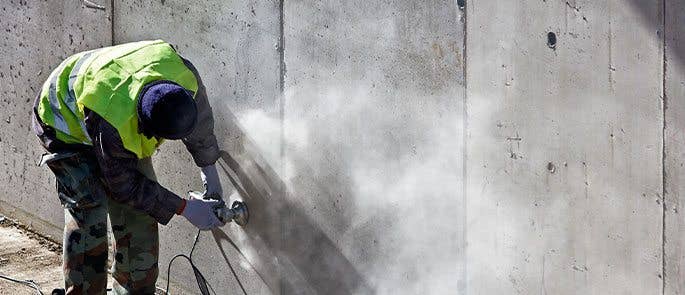
Grinding dust can cause fires in some circumstances. Some grinding tools – including angle grinders – produce sparks, something that is largely unavoidable. If these sparks come into contact with construction dust, it can cause a fire to start – particularly when grinding flammable materials such as aluminium or magnesium. To promote angle grinding safety, safety measures must be put in place to control the danger these sparks pose.
If you are working in the vicinity of flammable or explosive substances, there is a serious risk of these sparks creating a fire or explosion in the workplace if the correct safety precautions aren’t taken. You can learn more about controlling dust hazards in construction in our article, here.
It’s essential that anyone whose role involves grinding is aware of the hazards associated with this activity. Only once you understand the hazards associated with grinding and using abrasive wheels, can you take the appropriate steps to control them, ensuring a safe workplace for everyone.
Further Resources:
- 15 Workshop Hazards and How to Avoid Them
- Ten Common Construction Site Hazards
- What Are the Consequences of Poor Health and Safety Procedures?
- What is Hot Work and Do I Need a Permit?
- What Are the Key Differences Between Flammable and Combustible Materials?
- Health and Safety Training for Employees Course


